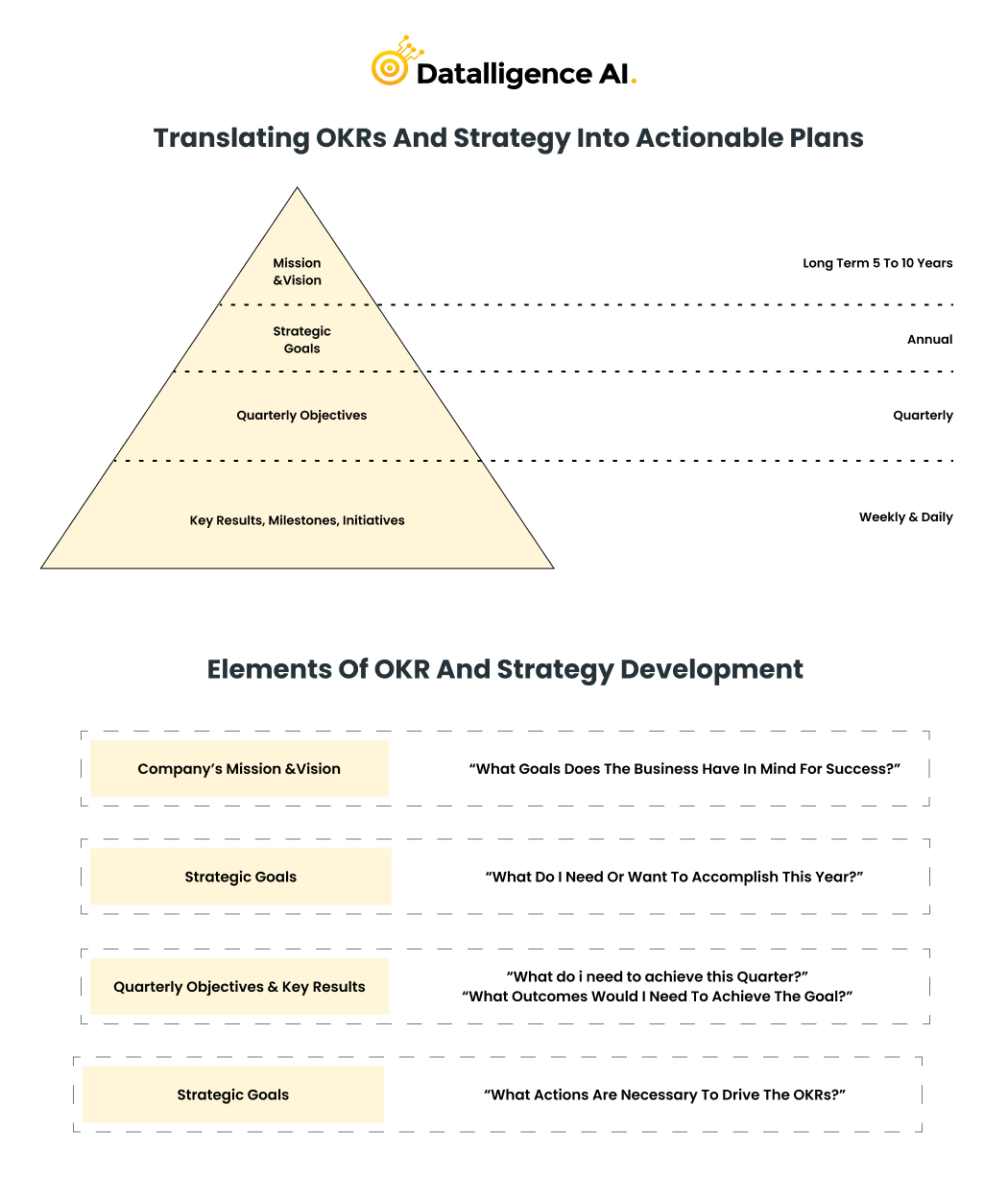Annual Strategy retreats consume a significant amount of time and effort. Over 90% of strategic plans are focused on increasing revenue, which is understandable because, without it, businesses would most likely fail over time.
When there are numerous opportunities, few resources, and a need for focus to take advantage of them, a solid strategy aids in deciding what to do and what to avoid doing.
The use of OKRs aids in translating strategy so that everyone in the organization, regardless of role, understands it and coordinates efforts to contribute to the crucial metrics that aid in executing strategy.
Introducing OKRs: Where do I begin?
OKR stands for Objectives and Key Results. It is a goal-setting framework that helps organizations, teams, and individuals define and track their objectives and measure their progress toward achieving them. OKRs provide a clear structure for setting ambitious goals and aligning efforts across the organization.
The framework consists of two main components:
Objectives: Objectives are ambitious and qualitative goals that define what an individual or team wants to achieve. They are typically short, inspirational statements that provide direction and purpose. Objectives should be challenging but achievable and should align with the overall mission and vision of the organization.
- Example Objective: Increase customer satisfaction and loyalty.
Key Results: Key Results are specific, measurable, and time-bound metrics that determine whether an objective has been accomplished. They are used to track progress and provide a quantitative way to assess success. Each objective can have multiple key results associated with it, usually between 2 to 5.
Example Key Results:
- Achieve a Net Promoter Score (NPS) of 8 or higher by the end of the quarter.
- Reduce customer churn rate by 20% within six months.
- Increase the average customer lifetime value by 15% in the next fiscal year.
The key results should be challenging and directly linked to the objective they support. They should be measurable and provide a clear indication of success or failure.
OKRs are typically set for a specific time frame, such as quarterly or annually, and are frequently reviewed and adjusted to ensure they remain relevant and aligned with changing circumstances. The idea behind OKRs is to set ambitious goals, encourage transparency, focus efforts on what truly matters, and foster a culture of continuous improvement and learning.
What are Strategy Maps
Strategy maps are visual tools that help organizations articulate and communicate their strategic objectives and the cause-and-effect relationships between different aspects of their business.
They provide a clear and comprehensive overview of the organization’s strategy, illustrating how various elements align to achieve desired outcomes. Strategy maps are typically presented in a graphical format, allowing for easy understanding and communication of the organization’s strategic direction.
Benefits of using Strategy Maps:
- Visual representation enhances understanding and communication of the organization’s strategy.
- Alignment of teams and departments towards common goals.
- Measurement of performance against strategic objectives through key performance indicators (KPIs).
- Improved communication and engagement with stakeholders.
- Strategic focus and prioritization of initiatives for maximum impact.
Executive teams can precisely define their execution map by writing a step-by-step approach using a potent tool like strategy maps.
How exactly do we convert these to OKRs now? Let’s investigate!
How To Translate OKRs and Strategy into Actionable Plans
Translating OKRs (Objectives and Key Results) and strategy into actionable plans involves breaking down the high-level goals and objectives into specific tasks and initiatives that can be executed by teams and individuals.
Here’s a step-by-step approach to help you translate OKRs and strategies into actionable plans:

Understand the OKRs and strategy
First, you need to gain a comprehensive understanding of the OKRs and the underlying strategy. The Objectives are the high-level, qualitative goals that an organization aims to achieve. They should be aspirational, time-bound, and actionable. Key Results, on the other hand, are specific, quantitative, and measurable outcomes that indicate progress toward achieving the Objectives.
Analyze and prioritize
Review the OKRs and strategy to identify critical areas and initiatives that will have the most significant impact on achieving the Objectives. Prioritize these initiatives based on their alignment with the OKRs and their potential to drive desired outcomes. Consider factors like resource availability, potential risks, and the estimated impact of each initiative on the overall goals.
Break down objectives
To achieve each Objective, break it down into smaller, more manageable components. These components should be specific and actionable.
For example, if the Objective is to “Increase market share,” some components could include “Launch a new marketing campaign,” “Expand distribution channels,” and “Improve product positioning.”
Define tasks and initiatives
For each component identified in the previous step, define the specific tasks and initiatives required to accomplish them. Ensure that the tasks are clear, specific, and assigned to responsible individuals or teams. Each task should be actionable and have a defined start and end date.
Determine resources and timelines
Assess the resources (human, financial, technological, etc.) required to execute the tasks and initiatives. Allocate resources appropriately and set realistic timelines for each task. Consider dependencies between tasks and adjust timelines accordingly. Be mindful of any limitations or constraints that may impact the execution of initiatives.
Establish performance indicators
Identify key performance indicators (KPIs) or metrics that will help measure progress and success. These KPIs should be aligned with the OKRs and provide meaningful insights into the performance of the initiatives and their impact on the Objectives. Continuously monitor and evaluate the KPIs to assess progress and make data-driven decisions.
5 Steps to Implement OKRs and Strategy
Implementing OKRs (Objectives and Key Results) and strategy involves a systematic approach to ensure successful execution and alignment within your organization.
Here are five steps to implement OKRs and strategy effectively:
1. Define Clear Objectives and Key Results:
- Start by defining clear and measurable objectives that align with your organization’s strategy. Objectives should be ambitious, outcome-oriented, and reflect the desired results you want to achieve.
- Identify Key Results for each Objective that serve as measurable milestones or indicators of progress. Key Results should be specific, quantifiable, and time-bound, providing a clear indication of success.

2. Cascade OKRs Across the Organization:
- Once you have defined your top-level Objectives and Key Results, cascade them down throughout your organization. This process involves aligning teams, departments, and individuals with the overarching strategy.
- Ensure that cascaded OKRs are aligned with higher-level Objectives while allowing flexibility for teams to set their own Key Results that contribute to the broader organizational goals.
3. Set Targets and Define Metrics:
- Establish targets and define metrics for each Key Result. Targets should be challenging yet achievable, pushing teams to strive for excellence.
- Metrics should be quantifiable and provide objective measurements of progress and success. Choose meaningful and relevant metrics that align with your Objectives and enable you to track performance effectively.
4. Regularly Track and Review Progress:
- Implement a system to regularly track and review progress toward the OKRs. This can include weekly or monthly check-ins, progress reports, or dashboards.
- Encourage open and transparent communication regarding progress, challenges, and opportunities. Regularly assess performance against Key Results and make necessary adjustments or interventions as required.
5. Foster a Culture of Alignment, Learning, and Adaptation:
- Foster a culture that emphasizes alignment, learning, and adaptation. Encourage collaboration and cross-functional communication to ensure that teams are working towards the same strategic goals.
- Emphasize the importance of learning from both successes and failures. Encourage experimentation and innovation, allowing teams to adapt their strategies and approaches as they gain insights from their OKR implementation.
Remember that OKRs and strategy implementation require ongoing commitment, engagement, and adaptability. Regularly revisit and refine your OKRs and strategic direction as needed to keep pace with changing market conditions, business priorities, and organizational goals.
Conclusion
Transferring Strategy Maps to OKRs is a valuable process that helps organizations align their strategic objectives with measurable outcomes. By translating the cause-and-effect relationships depicted in Strategy Maps into clear Objectives and Key Results, companies can drive focus, accountability, and progress tracking across their organization.
Datalligence, a leading OKR software platform, can greatly assist organizations in this journey. With its comprehensive suite of features, Datalligence provides a seamless and efficient solution for translating Strategy Maps into actionable OKRs. By leveraging Datalligence, organizations can streamline the process of implementing OKRs, align teams and individuals with strategic goals, and enhance performance management.
Talk to our experts and Performace coaches and gain more insights or Try Datalligence for free.











